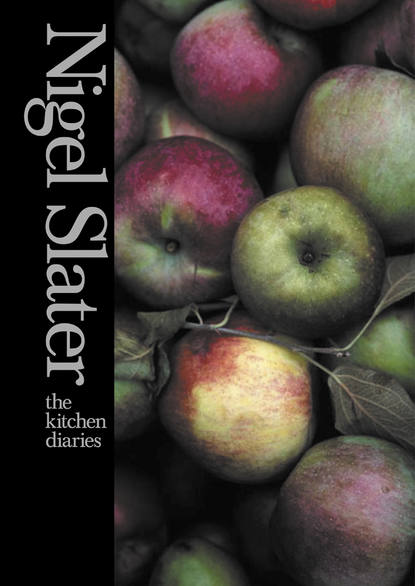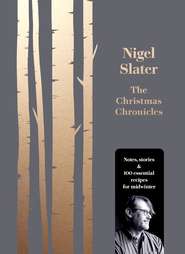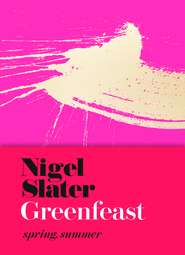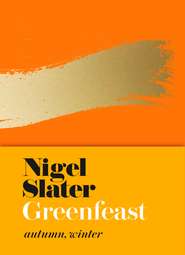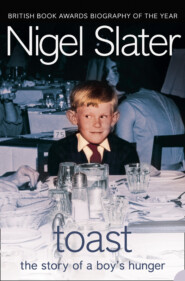По всем вопросам обращайтесь на: info@litportal.ru
(©) 2003-2024.
✖
The Kitchen Diaries
Настройки чтения
Размер шрифта
Высота строк
Поля
The Kitchen Diaries
Nigel Slater
Following the success of ‘Real Food’ and ‘Appetite’, this is the tenth book from Nigel Slater, the award-winning food writer and author of the bestselling autobiography, ‘Toast’.‘The food in “The Kitchen Diaries” is simply what I eat at home. The stuff I make for myself, for friends and family, for visitors and for parties, for Sunday lunch and for snacks. These are meals I make when I stop work, or when I am having mates over or when I want to surprise, seduce or show off. This is what I cook when I’m feeling energetic, lazy, hungry or late. It is what I eat when I’m not phoning out for pizza or going for a curry. This is the food that makes up my life, both the Monday to Friday stuff and that for weekends and special occasions.’‘Much of it is what you might call fast food, because I still believe that life is too short to spend all day at the stove, but some of it is unapologetically long, slow cooking. But without exception every single recipe in this book is a doddle to cook. A walk in the park. A piece of p***.’‘Fast food, slow food, big eats, little eats, quick pasta suppers, family roasts and even Christmas lunch. It is simply my stuff, what I cook and eat, every day. Nigel’s food – for you.’
Nigel Slater is the author of a collection of bestselling books and presenter of BBC I’s Simple Cooking and Dish of the Day. He has been food columnist for the Observer for twenty years. His books include the classics Appetite and The Kitchen Diaries and the critically acclaimed two-volume Tender. His award-winning memoir Toast – the story of a boy’s hunger won six major awards and is now a BBC film starring Helena Bonham Carter and Freddie Highmore. His writing has won the National Book Award, the Glenfiddich Trophy, the André Simon Memorial Prize and the British Biography of the Year. He was the winner of a Guild of Food Writers’ Award for his BBC I series Simple Suppers.
Also by Nigel Slater
The Kitchen Diaries II
Tender Volumes I and II
Eating for England
The Kitchen Diaries
Toast – the story of a boy’s hunger
Thirst
Appetite
Nigel Slater’s Real Food
Real Cooking
The 30-Minute Cook
Real Fast Food
Contents
Acknowledgements (#u5c54f348-3a10-4064-8866-3c908b6fb7c7)
January (#ud83708e5-fd89-4e2c-927c-6f155b0dc3c9)
February (#ue41aefe8-4f75-4c03-94f1-8e5d10b628f8)
March (#uedc960ea-7f2e-461f-9b93-8fb22028b188)
April (#litres_trial_promo)
May (#litres_trial_promo)
June (#litres_trial_promo)
July (#litres_trial_promo)
August (#litres_trial_promo)
September (#litres_trial_promo)
October (#litres_trial_promo)
November (#litres_trial_promo)
December (#litres_trial_promo)
Copyright (#litres_trial_promo)
About the Publisher (#litres_trial_promo)
To Digger, Magrath and Poppy
And to Louise and Jonnie with love
With thanks to Sam Blok, Araminta Whitley,
Allan Jenkins,Nung Puinongpho,
Jane Middleton, Silvia Crompton, and to Rohan and Sophie,
and everyone at 4th Estate
Right food, right place, right time. It is my belief – and the point of this book – that this is the best recipe of all. A crab sandwich by the sea on a June afternoon; a slice of roast goose with apple sauce and roast potatoes on Christmas Day; hot sausages and a chunk of roast pumpkin on a frost-sparkling night in November. These are meals whose success relies not on the expertise of the cook but on the more basic premise that this is the food of the moment – something eaten at a time when it is most appropriate, when the ingredients are at their peak of perfection, when the food, the cook and the time of year are at one with each other.
There is something deeply, unshakeably right about eating food in season: fresh runner beans in July, grilled sardines on a blisteringly hot August evening, a bowl of gently aromatic stew on a rainy day in February. Yes, it is about the quality of the ingredients too, their provenance and the way they are cooked, but the very best eating is also about the feeling that the time is right.
I do believe, for instance, that a cold Saturday in January is a good time to make gingerbread. It is when I made it and we had a good time with it. It felt right. So I offer it to you as a suggestion, just as I offer a cheesecake at Easter, a curry for a cold night in April and a pale gooseberry fool for a June afternoon. It is about seasonality, certainly, but also about going with the flow, cooking with the natural rhythm of the earth.
Learning to eat with the ebb and flow of the seasons is the single thing that has made my eating more enjoyable. Our culinary seasons have been blurred by commerce, and in particular by the supermarkets’ much vaunted idea that consumers want all things to be available all year round. I don’t believe this is true. I have honestly never met anyone who wants to eat a slice of watermelon on a cold March evening, or a plate of asparagus in January. It is a myth put about by the giant supermarkets. I worry that today it is all too easy to lose sight of food’s natural timing and, worse, to miss it when it is at its sublime best. Hence my attempt at writing a book about rebuilding a cook’s relationship with nature.
The diary
I wanted to know exactly when I might find something at its glorious, juicy, sweetly flavoured peak. If something is to be truly, remarkably good to eat, then isn’t it worth knowing precisely when that moment might be? ‘Spring’ or ‘autumn’ has always been too vague for me. There is a vast difference between winter-spring and summer-spring. Even labelling raw ingredients by the month in which they are due to ripen is a bit hit and miss (I missed the damsons and the greengages one year relying on that premise). Anyone who has gone to a farmers’ market in the first week of May and again in the last week will know where I am coming from. It is like two completely different months.
That said, this is not a book whose dates are to be followed like a mantra. It is simply a book of suggestions for when you might, should you care to look, find gooseberries, sprouts, damsons etc. at their best. It is a guide to what is and isn’t worth eating and when. And I like to think that there are few things more worth knowing than that. It is not some tyrannical culinary calendar but a book to dip in and out of throughout the year and the years to come, a reminder to keep an eye out for something, a gentle – and, I hope, delicious – aide-mémoire.
The
photographs
The photography has been done in ‘real time’. So when it says October 2nd or April 9th, then that is when the picture was shot. After I have cooked each meal and it has been photographed, we sit down and eat it while it is still hot. Then I wash up. The pictures are taken at home, so if you recognise plates and pans from my books Real Food or Appetite, then that is because they are things that I have come to love and cherish. Whether it’s a vegetable peeler or a palette knife, it works for me and has become part of my life.
The food
For the most part I shop at small local shops, farmers’ markets, proper butcher’s, fishmonger’s, delicatessens and cheese shops rather than all at once on a weekly trip to a supermarket. I have honestly never set foot inside a branch of Tesco. This book is very much a gentle plea to buy something, however small, each day, to take time to shop, to treat it as a pleasure rather than a chore. This doesn’t mean I spend my life shopping, far from it. It simply means that I stock up on dry goods, such as rice, pasta and the like, once a week, then manage to find half an hour a day (sometimes less) to buy just one or two fresh things from someone who sells them with a passion and a specialist interest – easier than ever now that shops tend to stay open later.
A weekly trip to the farmers’ market forms the backbone of my fresh food shopping, plus I have a weekly ‘organic box’ delivered to my door. I love to see those tables laid out under striped awnings with food that is being sold by the people who made or picked it. Shopping at the farmers’ market means that you can buy your cream from the person who churned it, your potatoes directly from the people who dug them from the ground, your salad leaves from the guy who planted the seeds. Food with a story you can follow from seed packet to table, picked that day. This, to me, is as good as food shopping gets.
Nigel Slater
Following the success of ‘Real Food’ and ‘Appetite’, this is the tenth book from Nigel Slater, the award-winning food writer and author of the bestselling autobiography, ‘Toast’.‘The food in “The Kitchen Diaries” is simply what I eat at home. The stuff I make for myself, for friends and family, for visitors and for parties, for Sunday lunch and for snacks. These are meals I make when I stop work, or when I am having mates over or when I want to surprise, seduce or show off. This is what I cook when I’m feeling energetic, lazy, hungry or late. It is what I eat when I’m not phoning out for pizza or going for a curry. This is the food that makes up my life, both the Monday to Friday stuff and that for weekends and special occasions.’‘Much of it is what you might call fast food, because I still believe that life is too short to spend all day at the stove, but some of it is unapologetically long, slow cooking. But without exception every single recipe in this book is a doddle to cook. A walk in the park. A piece of p***.’‘Fast food, slow food, big eats, little eats, quick pasta suppers, family roasts and even Christmas lunch. It is simply my stuff, what I cook and eat, every day. Nigel’s food – for you.’
Nigel Slater is the author of a collection of bestselling books and presenter of BBC I’s Simple Cooking and Dish of the Day. He has been food columnist for the Observer for twenty years. His books include the classics Appetite and The Kitchen Diaries and the critically acclaimed two-volume Tender. His award-winning memoir Toast – the story of a boy’s hunger won six major awards and is now a BBC film starring Helena Bonham Carter and Freddie Highmore. His writing has won the National Book Award, the Glenfiddich Trophy, the André Simon Memorial Prize and the British Biography of the Year. He was the winner of a Guild of Food Writers’ Award for his BBC I series Simple Suppers.
Also by Nigel Slater
The Kitchen Diaries II
Tender Volumes I and II
Eating for England
The Kitchen Diaries
Toast – the story of a boy’s hunger
Thirst
Appetite
Nigel Slater’s Real Food
Real Cooking
The 30-Minute Cook
Real Fast Food
Contents
Acknowledgements (#u5c54f348-3a10-4064-8866-3c908b6fb7c7)
January (#ud83708e5-fd89-4e2c-927c-6f155b0dc3c9)
February (#ue41aefe8-4f75-4c03-94f1-8e5d10b628f8)
March (#uedc960ea-7f2e-461f-9b93-8fb22028b188)
April (#litres_trial_promo)
May (#litres_trial_promo)
June (#litres_trial_promo)
July (#litres_trial_promo)
August (#litres_trial_promo)
September (#litres_trial_promo)
October (#litres_trial_promo)
November (#litres_trial_promo)
December (#litres_trial_promo)
Copyright (#litres_trial_promo)
About the Publisher (#litres_trial_promo)
To Digger, Magrath and Poppy
And to Louise and Jonnie with love
With thanks to Sam Blok, Araminta Whitley,
Allan Jenkins,Nung Puinongpho,
Jane Middleton, Silvia Crompton, and to Rohan and Sophie,
and everyone at 4th Estate
Right food, right place, right time. It is my belief – and the point of this book – that this is the best recipe of all. A crab sandwich by the sea on a June afternoon; a slice of roast goose with apple sauce and roast potatoes on Christmas Day; hot sausages and a chunk of roast pumpkin on a frost-sparkling night in November. These are meals whose success relies not on the expertise of the cook but on the more basic premise that this is the food of the moment – something eaten at a time when it is most appropriate, when the ingredients are at their peak of perfection, when the food, the cook and the time of year are at one with each other.
There is something deeply, unshakeably right about eating food in season: fresh runner beans in July, grilled sardines on a blisteringly hot August evening, a bowl of gently aromatic stew on a rainy day in February. Yes, it is about the quality of the ingredients too, their provenance and the way they are cooked, but the very best eating is also about the feeling that the time is right.
I do believe, for instance, that a cold Saturday in January is a good time to make gingerbread. It is when I made it and we had a good time with it. It felt right. So I offer it to you as a suggestion, just as I offer a cheesecake at Easter, a curry for a cold night in April and a pale gooseberry fool for a June afternoon. It is about seasonality, certainly, but also about going with the flow, cooking with the natural rhythm of the earth.
Learning to eat with the ebb and flow of the seasons is the single thing that has made my eating more enjoyable. Our culinary seasons have been blurred by commerce, and in particular by the supermarkets’ much vaunted idea that consumers want all things to be available all year round. I don’t believe this is true. I have honestly never met anyone who wants to eat a slice of watermelon on a cold March evening, or a plate of asparagus in January. It is a myth put about by the giant supermarkets. I worry that today it is all too easy to lose sight of food’s natural timing and, worse, to miss it when it is at its sublime best. Hence my attempt at writing a book about rebuilding a cook’s relationship with nature.
The diary
I wanted to know exactly when I might find something at its glorious, juicy, sweetly flavoured peak. If something is to be truly, remarkably good to eat, then isn’t it worth knowing precisely when that moment might be? ‘Spring’ or ‘autumn’ has always been too vague for me. There is a vast difference between winter-spring and summer-spring. Even labelling raw ingredients by the month in which they are due to ripen is a bit hit and miss (I missed the damsons and the greengages one year relying on that premise). Anyone who has gone to a farmers’ market in the first week of May and again in the last week will know where I am coming from. It is like two completely different months.
That said, this is not a book whose dates are to be followed like a mantra. It is simply a book of suggestions for when you might, should you care to look, find gooseberries, sprouts, damsons etc. at their best. It is a guide to what is and isn’t worth eating and when. And I like to think that there are few things more worth knowing than that. It is not some tyrannical culinary calendar but a book to dip in and out of throughout the year and the years to come, a reminder to keep an eye out for something, a gentle – and, I hope, delicious – aide-mémoire.
The
photographs
The photography has been done in ‘real time’. So when it says October 2nd or April 9th, then that is when the picture was shot. After I have cooked each meal and it has been photographed, we sit down and eat it while it is still hot. Then I wash up. The pictures are taken at home, so if you recognise plates and pans from my books Real Food or Appetite, then that is because they are things that I have come to love and cherish. Whether it’s a vegetable peeler or a palette knife, it works for me and has become part of my life.
The food
For the most part I shop at small local shops, farmers’ markets, proper butcher’s, fishmonger’s, delicatessens and cheese shops rather than all at once on a weekly trip to a supermarket. I have honestly never set foot inside a branch of Tesco. This book is very much a gentle plea to buy something, however small, each day, to take time to shop, to treat it as a pleasure rather than a chore. This doesn’t mean I spend my life shopping, far from it. It simply means that I stock up on dry goods, such as rice, pasta and the like, once a week, then manage to find half an hour a day (sometimes less) to buy just one or two fresh things from someone who sells them with a passion and a specialist interest – easier than ever now that shops tend to stay open later.
A weekly trip to the farmers’ market forms the backbone of my fresh food shopping, plus I have a weekly ‘organic box’ delivered to my door. I love to see those tables laid out under striped awnings with food that is being sold by the people who made or picked it. Shopping at the farmers’ market means that you can buy your cream from the person who churned it, your potatoes directly from the people who dug them from the ground, your salad leaves from the guy who planted the seeds. Food with a story you can follow from seed packet to table, picked that day. This, to me, is as good as food shopping gets.





